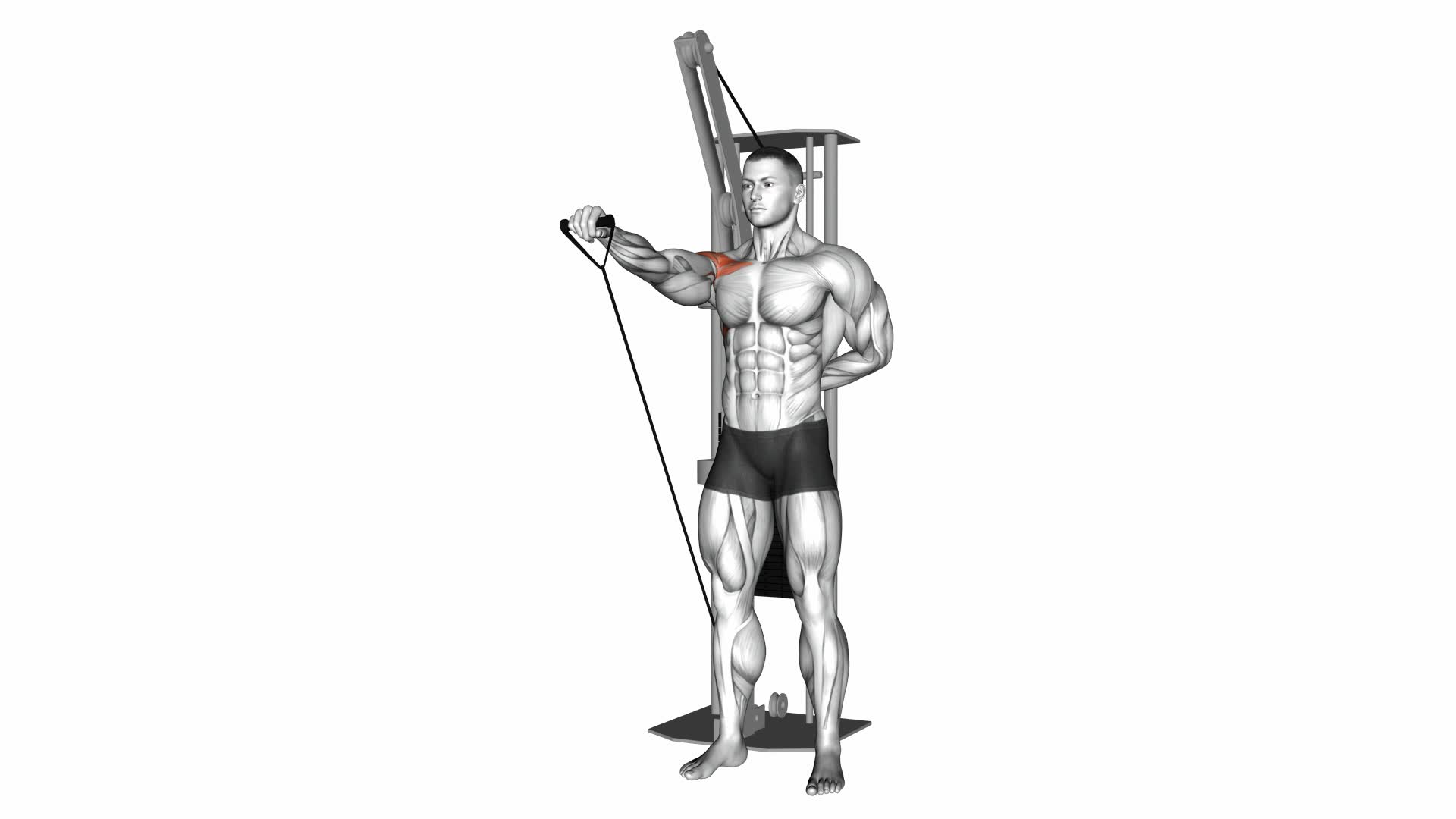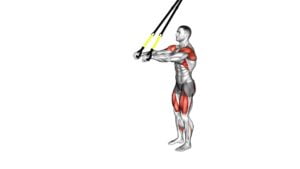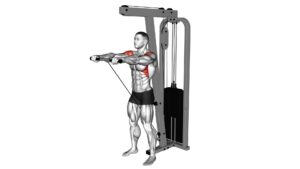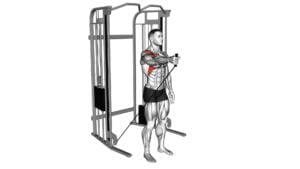Cable Forward Raise – Video Exercise Guide & Tips

In this article, you'll discover the proper form and technique for the cable forward raise exercise.
Watch This Exercise Video
With easy-to-follow video guides and helpful tips, you'll learn how to set up and adjust the equipment for maximum effectiveness.
Whether you're a beginner or advanced fitness enthusiast, there are variations for every fitness level.
We'll also cover common mistakes to avoid and provide tips to maximize shoulder engagement.
Plus, we'll include a sample workout routine to help you get started.
Let's dive in!
Key Takeaways
- Position yourself properly in front of the cable machine with feet shoulder-width apart and maintain a neutral spine throughout the movement.
- Set the cable heights correctly to allow your arms to fully extend without tension and adjust them for a more challenging workout.
- Prioritize equipment safety by regularly inspecting and cleaning it, checking for frayed or damaged cables, and tightening loose bolts or screws.
- Adjust the exercise to meet your individual needs by warming up properly, incorporating dynamic stretching exercises, and consulting with a fitness professional for guidance.
Proper Form and Technique
To ensure proper form and technique when performing the cable forward raise, position yourself in front of the cable machine with your feet shoulder-width apart. This exercise targets the front deltoids, providing strength and stability to your shoulders.
To avoid common mistakes and maximize shoulder engagement, keep the following tips in mind.
First, make sure to maintain a neutral spine throughout the movement. Avoid arching your back or leaning forward excessively, as this can put strain on your lower back. Engage your core muscles to stabilize your body and maintain proper alignment.
Next, focus on keeping your shoulders down and back. It's common for the shoulders to rise up towards the ears during the exercise, but this can lead to unnecessary tension and limit the effectiveness of the exercise. Imagine squeezing your shoulder blades together as you lift the cables, ensuring that your shoulders stay in a stable and engaged position.
Lastly, control the movement and avoid using momentum. Slowly raise the cables in a controlled manner, keeping your arms straight and your palms facing down. Avoid swinging or jerking the cables, as this takes away from the targeted muscle engagement.
Equipment Setup and Adjustment
To ensure proper cable forward raise execution, it's essential to set the cable heights correctly. This will allow you to maintain the right form and maximize the effectiveness of the exercise.
Additionally, it's crucial to prioritize equipment safety measures, such as ensuring the cables are securely attached and the machine is stable.
Lastly, adjust the equipment to meet your individual needs, considering factors like height, arm length, and comfort.
Proper Cable Heights
Adjust the cable heights on the equipment to ensure proper setup and maximize the effectiveness of your cable forward raise exercise. Proper cable heights are crucial for targeting the desired muscle groups and maintaining proper form throughout the exercise.
When performing the cable forward raise, the cables should be set at a height that allows your arms to fully extend without any tension on the cables when your arms are hanging down. This ensures that you're starting each repetition from a fully stretched position, engaging the muscles from the beginning of the movement. Incorrect cable heights can limit the range of motion and reduce the benefits of the exercise.
Remember, if the cable heights are too low, you can always adjust them higher for a more challenging workout.
Now that you have properly set up the cables, it's important to also consider equipment safety measures to prevent any injuries during your workout.
Equipment Safety Measures
Ensure your equipment is set up and adjusted properly to prioritize safety during your workout. Equipment maintenance is crucial for injury prevention and to ensure that your exercise equipment is functioning properly.
Before starting your workout, make sure that all cables, pulleys, and handles are in good condition and not frayed or damaged. Check for any loose bolts or screws and tighten them if necessary. Adjust the height of the cables according to your height and comfort level. Ensure that the weight stack is secure and doesn't exceed your capabilities. Always follow the manufacturer's instructions for proper setup and adjustments.
Regularly inspect and clean your equipment to keep it in good working condition. By taking these safety measures, you can minimize the risk of accidents and injuries during your workout.
Adjusting for Individual Needs
Make sure your equipment is properly set up and adjusted to meet your individual needs for a safe and effective workout. This is crucial for injury prevention and to ensure that you get the most out of your exercise routine.
Before starting any exercise, it's important to warm up properly. This helps prepare your body for the workout and reduces the risk of injury. Incorporate dynamic stretching exercises, such as arm circles or leg swings, to increase blood flow to your muscles and improve flexibility.
Additionally, adjust the cable height to match your height and range of motion. This will help you maintain proper form and target the muscles you intend to work on.
Variations for Different Fitness Levels
Let's take a look at the variations available for different fitness levels when it comes to cable forward raises.
If you're a beginner, there are modified exercises that can help you build strength and improve your form.
For those who are more advanced, there are options to challenge yourself and take your workout to the next level.
Whether you're just starting out or a seasoned pro, there's a variation that suits your fitness level.
Modified Exercises for Beginners
Start with modified exercises to accommodate different fitness levels.
When it comes to shoulder strengthening, beginners may need to start with exercises that are less intense and easier to perform. Modified exercises can help beginners build strength gradually while reducing the risk of injury.
One modification is to use lighter weights or resistance bands instead of heavy cables. This allows beginners to focus on proper form and technique without straining their muscles.
Another modification is to perform the exercise in a seated position instead of standing. This provides more stability and support for beginners who may have difficulty balancing.
Additionally, beginners can start with a lower number of repetitions and gradually increase as they become stronger and more comfortable with the exercise.
Remember to always listen to your body and consult with a fitness professional before starting any new exercises.
Advanced Options for Pros
Choose advanced variations of the Cable Forward Raise exercise to challenge yourself and continue progressing in your fitness journey. Incorporating advanced techniques and advanced progressions into your workouts can help take your strength and shoulder stability to the next level.
One option is to increase the weight or resistance on the cable machine to make the exercise more challenging.
Another option is to perform the exercise on an unstable surface, such as a Bosu ball, to engage your core muscles even more.
Additionally, you can try performing the exercise with a single arm instead of both arms at the same time, which will further challenge your balance and stability.
Keep pushing yourself with these advanced variations to see continued improvement.
Now, let's move on to the next section and discuss common mistakes to avoid.
Common Mistakes to Avoid
One common mistake to avoid when performing the cable forward raise is allowing your shoulders to hunch up towards your ears. This is a common mistake that can compromise the effectiveness of the exercise and lead to improper shoulder engagement. When your shoulders hunch up, it causes unnecessary tension in the neck and upper back muscles, taking the focus away from the targeted shoulder muscles. To avoid this mistake, focus on keeping your shoulders down and back throughout the entire movement. Imagine pulling your shoulder blades together and down towards your back pockets. This will help to engage the correct muscles and maintain proper form.
Another common mistake to avoid is using too much weight. It's important to choose a weight that allows you to perform the exercise with proper form and control. Using too much weight can lead to swinging or jerking motions, which can put unnecessary strain on the shoulder joints and increase the risk of injury. Start with a lighter weight and gradually increase as you become more comfortable and confident with the exercise.
Lastly, make sure to maintain a neutral spine throughout the exercise. Avoid rounding or arching your back, as this can put strain on the lower back and take away from the effectiveness of the exercise. Keep your core engaged and your spine in a neutral position to ensure proper form and maximize the benefits of the cable forward raise.
Tips for Maximizing Shoulder Engagement
To maximize shoulder engagement during the cable forward raise, focus on maintaining proper form and activating the targeted muscles. Proper form is crucial for maximizing shoulder strength and preventing injury.
Start by standing with your feet shoulder-width apart and your knees slightly bent. Hold the cable handles with your palms facing down and your arms extended in front of you. As you lift the cables, keep your shoulders down and back, and avoid shrugging your shoulders. This will help to engage the muscles in your shoulders, specifically the deltoids.
To further maximize shoulder engagement, incorporate shoulder stability exercises into your routine. These exercises help to strengthen the muscles surrounding the shoulder joint, improving stability and reducing the risk of injury. Examples of shoulder stability exercises include shoulder external rotation, scapular retraction, and shoulder abduction.
Adding these exercises to your workout routine won't only enhance shoulder engagement during the cable forward raise but also improve overall shoulder strength and stability. Remember to start with lighter weights and gradually increase the resistance as your shoulder strength improves.
Sample Workout Routine With Cable Forward Raise
To incorporate the cable forward raise into your workout routine, perform 3 sets of 10 repetitions, focusing on maintaining proper form and engaging your shoulder muscles throughout each movement. This exercise is an excellent way to target your anterior deltoids and improve your shoulder strength and stability.
Here is a sample workout routine that includes the cable forward raise:
- Warm up: Start with 5-10 minutes of light cardio to get your blood flowing and your muscles warmed up.
- Main workout:
- Cable forward raise: Perform 3 sets of 10 repetitions with a challenging weight. Keep your arms straight and raise them in front of you until they're parallel to the floor. Lower the weight back down slowly and repeat.
- Superset with lateral raises: Immediately after each set of cable forward raises, perform 3 sets of 10 lateral raises. Stand with your feet hip-width apart and raise your arms out to the sides until they're parallel to the floor. Lower them back down slowly and repeat.
- Cool down: Finish your workout with some light stretching to help prevent muscle soreness.
Frequently Asked Questions
How Many Sets and Reps Should I Perform for Cable Forward Raises?
For cable forward raises, the number of sets and reps you should perform depends on your fitness level and goals. This exercise is a great shoulder exercise variation that targets the front delts.
Cable exercises offer benefits like constant tension and a wide range of motion. Start with 3 sets of 10-12 reps and gradually increase as you become stronger.
Remember to use proper form and control throughout the exercise to maximize results and prevent injury.
Can Cable Forward Raises Be Performed Using Dumbbells Instead of a Cable Machine?
Yes, you can perform dumbbell alternatives for cable forward raises. While the cable machine offers benefits like constant tension throughout the movement, dumbbells can still target the same muscles.
Dumbbell forward raises engage your shoulders and upper body, helping to build strength and definition. However, it's important to note that the cable machine allows for a greater range of motion and more resistance options.
Are There Any Modifications for Individuals With Shoulder Injuries or Limitations?
If you have a shoulder injury or limitations, there are modifications you can make to the cable forward raise exercise. Instead of using a cable machine, you can try using dumbbells or resistance bands. These alternatives can help reduce strain on your shoulders while still targeting the same muscle groups.
Additionally, there are other exercises you can incorporate into your routine that focus on strengthening the shoulders without putting too much stress on them.
Should I Incorporate Cable Forward Raises Into My Shoulder Workout or Perform Them on a Separate Day?
You should consider incorporating cable forward raises into your shoulder workout rather than performing them on a separate day.
Cable forward raises are a great exercise for targeting the front deltoids, and they also engage the lateral deltoids and upper chest muscles.
Performing them in your shoulder workout will allow you to maximize the benefits and efficiency of your routine.
Remember to maintain proper form and technique to avoid injury and ensure optimal results.
How Often Should I Perform Cable Forward Raises to See Results?
To see results from cable forward raises, you need to perform them with the right frequency. Prioritize consistency and aim to do them at least two to three times a week.
This exercise targets your shoulder muscles, helping to strengthen and tone them. The benefits of cable forward raises include improved shoulder stability and increased range of motion.
Incorporate them into your regular shoulder workout routine for maximum effectiveness.
Conclusion
In conclusion, the cable forward raise is an effective exercise for targeting the shoulders. By maintaining proper form and technique, adjusting equipment accordingly, and avoiding common mistakes, you can maximize shoulder engagement and achieve optimal results.
Additionally, incorporating variations for different fitness levels and following a sample workout routine can help you progress and challenge yourself.
Remember to consult with a fitness professional for personalized guidance and to ensure safety during your workout.

Author
Years ago, the spark of my life’s passion ignited in my mind the moment I stepped into the local gym for the first time. The inaugural bead of perspiration, the initial endeavor, the very first surge of endorphins, and a sense of pride that washed over me post-workout marked the beginning of my deep-seated interest in strength sports, fitness, and sports nutrition. This very curiosity blossomed rapidly into a profound fascination, propelling me to earn a Master’s degree in Physical Education from the Academy of Physical Education in Krakow, followed by a Sports Manager diploma from the Jagiellonian University. My journey of growth led me to gain more specialized qualifications, such as being a certified personal trainer with a focus on sports dietetics, a lifeguard, and an instructor for wellness and corrective gymnastics. Theoretical knowledge paired seamlessly with practical experience, reinforcing my belief that the transformation of individuals under my guidance was also a reflection of my personal growth. This belief holds true even today. Each day, I strive to push the boundaries and explore new realms. These realms gently elevate me to greater heights. The unique combination of passion for my field and the continuous quest for growth fuels my drive to break new ground.



